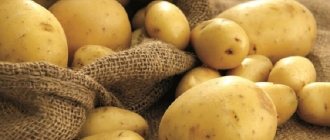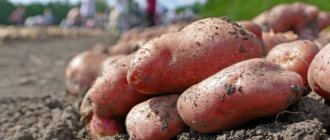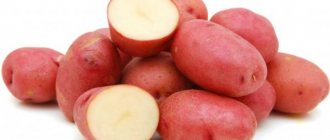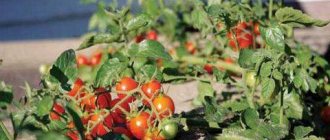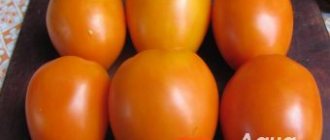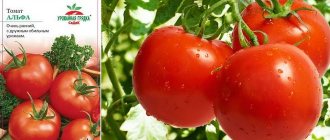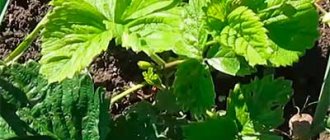Description, origin and development
Potato Krepysh is a Russian table variety of early ripening. They started growing it relatively recently. Krepysh was bred as a result of breeding work in 2000. This event took place at the All-Russian Research Institute of Potato Farming named after A.G. Lorha."
To obtain the variety, breeders used the numbered hybrid 2953-34 and potatoes of the Shurminsky-2 variety. Krepysh was included in the State Register of Plants of the Russian Federation in 2005.
Appearance of Krepysha tubers
Ripening time and yield
Krepysh is classified as an early ripening potato variety. After planting, the tubers need from 60 to 80 days to fully ripen (depending on the climatic conditions of the region). The first harvest can be harvested after 45 days.
Note! If all agrotechnical requirements are followed during the growing process, then from one bush you can collect from 15 to 20 tubers.
Disease resistance
Today, the Krepysh potato is very popular, the description of which indicates that the variety is resistant to scab, potato cancer, and golden cyst nematode.
Characteristics of tubers, description of appearance
Potato tubers Krepysh are oval and oblong in shape. They weigh on average from 80 to 105 grams. The skin on them is smooth and thin, yellow in color. Eyes are very rare.
The bushes are medium-sized, erect, growing up to 60 cm in height. They produce medium-sized green or dark green leaves with slightly wavy edges.
For reference! Flowering lasts for two weeks. At this time, bright purple flowers with a red tint appear on the bushes.
For which regions is it suitable, climate requirements?
Since the potato variety is unpretentious, it can be grown in all regions of Russia. The strong plant is also unpretentious to the climate and soil composition, which makes it very popular and in demand.
Seed potatoes Krepysh
Taste qualities
The Krepysh potato variety has excellent taste. The pulp of the tubers is cream-colored and has a delicate taste. Wateriness is completely absent. After cooking, the potatoes do not turn black and retain their shape well.
List of popular varieties
There is a wide variety of potato types that have gained recognition among gardeners. According to the description, they have excellent taste and high yield.
Division by ripening period
According to the speed of ripening, experts divide potatoes into:
- ultra-early and early;
- mid-season;
- late ripening;
In the northern part of Russia, preference is given to early ripening varieties, in the Central region - medium and early varieties. Late varieties are grown for long-term storage, as well as in areas where frosts arrive late.
Early
The category of early and ultra-early species includes potatoes, the technical maturity of which occurs 35-60 days after planting in the ground. In the southern regions it is used to obtain two harvests per season. The main disadvantage is the low storage performance.
For your information! Ultra-early and early types of potatoes are not used for storage during the winter.
- Zhukovsky early. Technical maturity occurs in 60-70 days. Characterized by stable high yield;
- Impala is a tall, early maturing species. Tolerates drought well, suitable for cultivation in southern regions;
- Minevra. Ultra-early high-yielding variety of Dutch selection. It has a pleasant taste. Disadvantages include the need for water;
- Rosara. Early potatoes with high yield. Adapts well to new conditions. Resistant to viral and fungal diseases. It has high taste qualities.
The ranking of the best early ripening varieties also includes Ariel, Riviera, Vyatka, and Domodedovo.
Average
Mid-season potatoes are suitable for growing in both the southern, central and northern regions. The crop ripens 90-110 days after planting in the ground.
It is worth taking a closer look at the following varieties:
- Aurora. Mid-early table variety. Differs in the tall size of the bushes. Has excellent taste. Among the disadvantages - average resistance to viruses and pests;
- Breeze. Mid-early variety of Belarusian selection. Up to 600 centners are collected from 1 hectare. Stores well in winter. Resistant to mechanical damage;
- Vector. High-yielding variety with a pleasant taste. Resistant to cancer, late blight, mosaic.
The TOP of the best mid-season and mid-early varieties also includes Zekura, Ryabinushka, Svitanok Kyiv, Lugovskoy, Skarb, Tuleevsky, Kolobok.
Late
Late species have a long growing season. The harvest ripens 100-120 days after planting. These varieties are grown in regions with warm or temperate climates. Most often, gardeners choose:
- Asterix. It has a red peel color and a pleasant taste. The main disadvantage is weak immunity;
- Crane link. Zhuravlinka has average yields. The variety has become widespread due to its good taste. Requiring care;
- Kiwi. Rare productive variety. It is easily adaptable to various conditions. Has mediocre taste;
- Cudora. It has a pleasant taste and high yield. It is characterized by a high starch content in tubers.
Note! Planting material for the Kiwi variety is difficult to find on sale. It got its name due to the elongated shape of the tubers with a rough skin. Of the later types, Lasunak, Picasso, Manifesto, Sonny, Tempo, Violet, Desiree are also noted
Of the later types, Lasunak, Picasso, Manifesto, Sonny, Tempo, Violet, Desiree are also noted.
According to quality characteristics
According to their quality characteristics, varieties are distinguished:
- with increased productivity;
- high in starch;
- by color;
- crumbly or boiled.
The potatoes stand out separately and stand out for their taste.
Important! The main qualitative selection criterion is productivity. It is directly related to agricultural technology and crop resistance to diseases and pests. The best potato varieties by yield:
The best potato varieties by yield:
- Bellarosa (up to 300 c/ha);
- Veneta (up to 400 c/ha);
- Gala (up to 400 c/ha);
- Sante (up to 500 c/ha);
- Luck (400-450 c/ha).
When choosing a variety to suit your taste, you should focus on the potato variety, the best quality characteristics of which have been confirmed by many gardeners.
Popular potato varieties based on taste characteristics include:
These species have shown consistently high yields and are distinguished by excellent taste. They are suitable for frying, boiling, stewing, and making chips.
Another quality indicator is the starch content. Gardeners distinguish a number of varieties that are distinguished by their high content.
The maximum amount of potato starch is contained in the following varieties:
- Blueness (up to 19%);
- Lugovskoy (up to 19%);
- Lorch (at least 20%);
- Lasunok (at least 22%).
Main advantages and disadvantages
According to reviews and characteristics, the Krepysh potato variety has a lot of advantages. The following are considered the main ones:
- ability to be stored for a long time at early stages of ripening;
- early maturation;
- ease of care;
- undemanding to climatic conditions;
- smooth fruits;
- high productivity;
- excellent taste;
- with proper storage, the tubers do not rot or wither;
- tubers tolerate transportation well;
- The variety is resistant to pests and diseases.
Nuances of care
The innovator is unpretentious. You cannot count on a decent harvest without watering, pest and disease control, and weeding. Proper care will reduce the number of small tubers from each bush.
Watering mode
The first soil moistening is carried out during the formation of buds, the second - after flowering. In the future, watering should be moderate, the frequency depends on weather conditions. Excess moisture can cause tuber crops to become infected with rot.
Top dressing
Common fertilizers include:
- bird droppings - diluted with water in a ratio of 1 to 10;
- urea - for 10 liters of liquid take 1 tbsp. a spoonful of the substance, poured under the root, first loosen the soil a little;
- mullein - take 10 liters of water per liter of fresh manure.
Fertilizing is carried out between the rows. Mineral fertilizers are applied in the spring, in compliance with the proportions indicated on the package. Excessive intake of nutrients can negatively affect the harvest and cause plant death.
Weeding and hilling
Loosening of the soil is carried out at least three times during the season. After rains or watering, hilling is recommended:
- first time - 2-3 weeks from the day of planting;
- the second – after the same period after primary treatment;
- the third - a week before flowering.
The frequency of weeding depends on the type of planting: if pre-sprouted tubers were used, then the procedure takes place three weeks after planting the seedlings and before the bushes flower. In the case of using seed material, as the weed grows, sometimes the first weed removal is done before the first potato sprouts appear.
Disease and pest control
Work is carried out depending on the type of lesion. Late blight is destroyed by spraying with copper sulfate - two weeks after germination. To prevent the development of rhizoctonia, seed material is treated with a 1% solution of boric acid before planting; Ditan M-45 (80%) can be used.
Powdery scab requires spraying the tubers with a 5% solution of copper sulfate. If the site has been attacked by the golden potato cyst nematode, the tops and plant residues are burned, and the next planting of potatoes is allowed only after four years. The fight against the Colorado potato beetle involves pollinating plants with insecticides.
Planting and growing
In order for potatoes to develop well, it is necessary to approach the process of planting and growing responsibly.
Krepysh potato bushes in the field
Preparing for landing
For planting, experts recommend purchasing seed material from a nursery or using last year’s root crops grown independently. Potatoes should be moved to a well-lit and ventilated area two weeks before planting. The temperature in it should not be lower than +18 degrees. As soon as the sprouts grow to a length of about 2-3 centimeters, the tubers can be planted.
Note! To make sprouts appear on potatoes faster, it is recommended to turn the tubers over and spray them with water every two days.
The day before planting, the tubers must be disinfected and treated with fungicides.
Soil requirements
The soil for root crops needs to be prepared in the fall. To do this, the area is dug up, stones, roots and weeds are removed from it. In addition, a prerequisite for a good harvest is the application of fertilizers to the soil. You can use chicken manure, manure, wood ash or compost.
With the onset of spring, the soil is dug up again and mineral fertilizers are added to it.
Dates, scheme and rules of planting
Krepysh potatoes should be planted in early or mid-May. The most important thing is that the soil warms up to +10 degrees.
The planting scheme for this root crop is as follows:
- on a pre-prepared area, even beds are formed, the distance between which should vary from 60 to 65 cm;
- then holes are dug at a distance from each other from 30 to 35 cm;
- the soil in the holes is moistened with water and tubers are placed in each hole, the eyes of which should look up;
- the beds are leveled and mulched.
The depth of planting material depends on the quality of the soil. If it is loose and airy, then the potatoes are buried approximately 15 cm, light and slightly damp by 10 cm, and heavy and wet by 5 cm.
Potato planting scheme
Agricultural technology
Preparation and transfer to the ground
Potatoes of this variety adapt well to a wide variety of soils, but adapt best to light soils. Before planting, you will need to select intact medium-sized tubers.
Cabbage Kolobok
Additional Information. High-quality material can also be purchased in specialized centers and stores.
Before planting, pre-sorted tuber preparations are germinated in the light until shoots about 2-3 cm long appear.
The area on which this type of potato is planted should be prepared in advance: by carefully digging it up and fertilizing it in the fall. With the arrival of spring, it is enough to dig up the beds again and clear them of weeds, then add phosphorus and potassium fertilizers to the loose soil.
To speed up the maturation process, it is enough to follow these simple rules:
- Before planting the prepared material, you must wait until the soil at the planting depth (10-12 cm) warms up to at least +8 degrees.
- In terms of time, these procedures should be tied to the first half of May, when the eyes of the blanks slightly begin to sprout.
- The soil prepared for planting should be moderately moist.
- The planting itself is carried out in rows located along a linear north-south axis, which will provide future plants with acceptable sunlight.
- If groundwater is close, planting should be done in beds slightly elevated above ground level.
- The gap left between the rows should allow you to easily care for the growing bushes (for this it is taken to be at least 60 cm).
- The planting step for potato nests is usually about 30-35 cm.
It is best to plant potatoes in the first half of May.
When carrying out planting work, add a small handful of ash and about the same amount of compost or humus to each hole. Some potato growers replace them with a mixture of organic fertilizers applied at the rate of about 20 grams per nest.
Features of care and collection
Caring for potatoes of this variety comes down to their hilling, fertilizing and abundant watering, organized during the formation of the ovaries. Loosening the soil should be done three times during the growing season, namely:
- First, when the height of the bushes reaches 25 cm.
- The second time they spud in about 2-3 weeks.
- Another loosening is organized approximately 24 days before harvesting.
Important! In dry weather, in the intervals between loosening, it is advisable to organize sprinkling of the tops. At the end of the flowering period, watering potatoes is undesirable, since the abundance of moisture can threaten the disease with late blight.
During the entire growing season, 2-3 feedings of the nests of the growing plant are also carried out using potassium supplements mixed with droppings or mullein. To avoid drying out of the soil during this period, another hilling with simultaneous mulching is organized
At the end of the flowering period, watering potatoes is undesirable, since an abundance of moisture can threaten late blight. During the entire growing season, 2-3 feedings of the nests of the growing plant are also carried out using potassium supplements mixed with droppings or mullein. To avoid drying out of the soil during this period, another hilling with simultaneous mulching is organized.
A sign of the ripening of plant tubers is the complete drying of its stems, which are most often cut off in the form of tops for ease of harvesting. After this, the potatoes are dug up and placed in one row under a canopy to dry.
Drying of the tops is a sign of potato ripening
How to properly care for the variety
Krepysh potatoes are unpretentious varieties, but this does not mean that they do not need to be looked after. In order to obtain a bountiful and high-quality harvest, it is necessary to comply with certain agrotechnical rules and regulations.
Features of watering
The variety is undemanding when it comes to watering, so under favorable weather conditions it is enough to water the crop only 3 times per season. The first watering is carried out as soon as the sprouts reach a height of 20 cm. The second watering is carried out during budding, and the third after flowering.
Experts recommend focusing on the condition of the soil. The root crop should be watered as soon as the soil dries to a depth of about 15 cm. For watering, it is best to use rain or settled water. It needs to be poured at the root; 3 liters of water should be poured under each bush.
Advice from experienced gardeners and reviews about the Krepysh variety
Advice from experienced farmers that will help you get a high-quality and abundant harvest:
- Plant potatoes only in well-warmed soil, otherwise the tubers will rot.
- Change the location for planting potatoes every year.
- Be sure to spray the bushes to prevent diseases and pest attacks.
- Keep an eye on watering. Do not allow water to get on the leaves - this will lead to the development of late blight and the death of most of the crop.
Krepysh is a young variety that has already become a favorite of many gardeners , which is confirmed by positive reviews.
Valentina, Vologda region. : “I grow potatoes at the dacha, a couple of years ago I decided to plant Krepysh and was not disappointed. What attracted me most was the variety’s ability to tolerate short-term drought, because I can only come to the dacha once a week. The yield is encouraging - we have more than enough for two large families.”
Nikolay, Tver : “Strong is a telling name for this variety. The tubers are large, beautiful, the harvest is rich - enough for yourself and for sale. I store potatoes in the cellar, but in mid-April it becomes humid there, so I move the leftovers to a drier place. I hill up with a mini-cultivator - it’s very convenient.”
How to harvest and store crops
As soon as the tops on the bushes darken, you can begin harvesting. Ripening occurs already on the 45th day after the sprouts appear, but digging up potatoes for storage at this time is not recommended. You should wait a few more weeks.
Potato harvest
Storage features and keeping quality of the variety
As soon as the time comes to dig up the potatoes, you need to take care of their drying and further storage. After digging, the tubers are dried in the sun for several hours. After that they sort through.
Tubers suitable for storage are placed in wooden boxes or bags.
Attention! Potatoes should be stored in a well-ventilated, dry and dark room, the temperature in which varies from +1 to +4 degrees.
The keeping quality of the variety is about 97%. If you provide potatoes with the correct storage conditions, they will retain their presentation and taste until spring.
Diseases and pests
Krepysh potatoes are susceptible to late blight and other fungal diseases such as fusarium, blackleg, rhizoctania and alternaria. Such problems can be dealt with using fungicidal antifungal drugs.
The plant can also be attacked by pests such as the Colorado potato beetle, black aphids, wireworms and mole crickets. Experienced agronomists prefer to combat them with the help of broad-spectrum insecticides that are sprayed on the bushes.
Those who want to grow an early variety of tasty potatoes on their plot are recommended to pay attention to Krepysh. It appealed to farmers from different regions of the country. The popularity of the variety is explained by its positive qualities, which include unpretentiousness, ease of care and excellent taste. Among other things, the tubers are distinguished by their high shelf life, which not all early varieties can boast of.
Advantages of fertilizer Krepysh
Based on numerous reviews from gardeners, we can conclude that the drug Krepysh has a large number of positive qualities.
Water-soluble organomineral fertilizer with potassium humate FASKO “Krepysh”
- The product is universal - suitable for many types of plants. There are species for seedlings and adult crops.
- The fertilizer is economical because it is highly concentrated. At the same time, the product contains many elements; with one fertilizing, the crop receives a whole complex of substances at once and additional fertilizers are not required.
- Plants quickly respond to the application of Krepysh fertilizer.
- The drug dissolves easily in water and is sold in packages with different quantities.
- It is convenient to store the drug.
